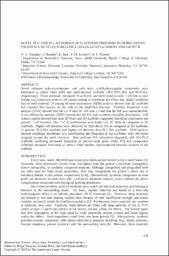| dc.contributor.author | Varanasi, Venu | |
| dc.contributor.author | Russias, J | |
| dc.contributor.author | Saiz, E | |
| dc.contributor.author | Loomer, PM | |
| dc.contributor.author | Tomsia, AP | |
| dc.date.accessioned | 2019-01-23T22:29:55Z | |
| dc.date.available | 2019-01-23T22:29:55Z | |
| dc.date.issued | 2015 | |
| dc.identifier.citation | Varanasi, V. G., Russias, J. , Saiz, E. , Loomer, P. M. and Tomsia, A. P. (2015). Novel Pla‐ and Pcl‐ha Porous 3D Scaffolds Prepared by Robocasting Facilitate MC3T3‐E1 Subclone 4 Cellular Attachment and Growth. In Biomaterials Science: Processing, Properties, and Applications V (eds R. Narayan, S. Bose and A. Bandyopadhyay). Original publication at https://ceramics.onlinelibrary.wiley.com/doi/abs/10.1002/9781119190134.ch16 | en_US |
| dc.identifier.other | 10.1002/9781119190134.ch16 | |
| dc.identifier.uri | http://hdl.handle.net/10106/27641 | |
| dc.description.abstract | **Please note that the full text is embargoed** ABSTRACT: Novel robocast poly‐caprolactone‐ and poly‐lactic acid‐hydroxyapatite composites were fabricated as planar films (2D) and multi‐layered scaffolds (3D) (PCL‐HA and PLA‐HA, respectively). These materials contained 70 wt.% HA and were tested in vitro. Cell‐free in vitro testing was conducted prior to cell culture testing to determine the effect that media conditions had on each material. Scanning electron microscopy (SEM) analysis showed that 3D scaffolds had exposed HA crystals on the rods of the mesh‐like structure. Electron dispersive x‐ray analysis (EDX) showed that the Ca: P ratio for HA was 1.3 and that the HA was carbonate‐free. X‐ray diffraction analysis (XRD) showed that the HA had a random crystallite distribution. Cell culture studies showed that both 2D films and 3D scaffolds supported osteoblast attachment and growth. Cell densities after 7 d of proliferation were higher on 2D films as compared to 3D scaffolds. Higher cell densities were observed for fully‐dense HA as compared to 3D scaffolds. In general, PLA‐HA scaffolds had higher cell densities than PCL‐HA scaffolds. SEM analysis showed osteoblast attachment (via lamellipodia and filopodia) to the scaffolds, with cell layers wrapped around the mesh structure. Both polymer‐HA composites degraded, with HA‐PLA scaffolds exhibiting increased formation of micron‐sized pores while PCL‐HA composites exhibited increased formation of surface fiber bundles interconnected between features of the scaffold. | en_US |
| dc.language.iso | en | en_US |
| dc.publisher | Wiley | en_US |
| dc.relation.ispartofseries | Ceramic Transactions Series; | |
| dc.subject | 3D scaffolds | en_US |
| dc.subject | Robocast | en_US |
| dc.subject | Cell culture study | en_US |
| dc.subject | X-ray analysis | en_US |
| dc.subject | Crystallite distribution | en_US |
| dc.title | Novel PLA- and PCL-HA Porous 3D Scaffolds Prepared by Robocasting Faciliate MC3T3-E1 Subclone 4 Cellular Attachment and Growth | en_US |
| dc.type | Book chapter | en_US |

